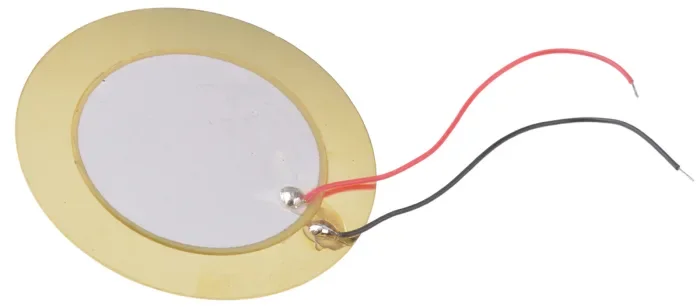Piezoelectric Sound Design: How Piezo Speakers Shape UX Audio in Modern Devices
Piezoelectric sound design is the craft of creating clear, purposeful audio for devices that rely on piezo speakers and buzzers - tiny components found in wearables, smart home tech, robotics, and medical tools. These compact transducers can’t deliver full-range audio like a traditional speaker, which makes every tone, chime, and alert critical. Thoughtful sound design turns those simple beeps into a functional language: guiding users, signaling reliability, and giving modern products a distinct audible identity.
Classic Piezo “Alarm” or “Alert” sound.
Piezo Notification
Piezo Notification Alternative
What Is Piezoelectric Speaker?
A piezo speaker or piezo buzzer is a very small component that creates sound using a thin disk of piezoelectric material. When an electrical signal passes through this material, it flexes back and forth at high speed, creating vibrations that produce sound. Unlike a full-size speaker, a piezo transducer is extremely compact and efficient, making it perfect for devices that don’t have room or battery power for large audio systems.
Because of these advantages, piezo speakers and buzzers are everywhere: smartwatches, fitness trackers, smart locks, thermostats, medical devices, robotics, and other modern wearables. They deliver short tones, alerts, and notification sounds that guide users through interactions without relying solely on visuals or haptics.
Casio watch
Piezoelectric sound design
Is the process of crafting those tones and patterns so that, despite the hardware limitations, the sound feels clear, purposeful, and branded. It ensures that every beep, click, or chime enhances the user’s experience and reinforces the product’s identity rather than sounding generic or harsh.
Why These Tiny Speakers Matter
Even on small devices, sound quality shapes the way users experience technology. A single tone from a piezo speaker can confirm an action, guide attention, and create a subtle emotional response. When that sound is harsh or generic, it makes the product feel cheap. When it’s clear and well‑crafted, it builds confidence and reinforces a sense of quality.
If you’ve ever wondered about the myriad of little sounds emanating from your devices, that’s piezoelectric sound design at work.
Benefits of Piezoelectric Speakers and Buzzers:
Lightweight and efficient – Ideal for battery-powered wearables and IoT devices.
Perfect for smart devices – Fits where traditional speakers can’t.
Able to deliver custom audio cues – Even with limited size, a piezo transducer can be tuned to create distinct, recognizable tones.
Lead Wire Piezo Buzzer
These small components do more than make noise - they help devices communicate, reassure users, and bring a product’s character to life.
The Challenges of Piezo Sound Design
Designing sound for a piezo speaker or piezo buzzer comes with unique constraints. These components have a narrow frequency range and very small drivers, which means the tones they produce can easily sound harsh, thin, or even unpleasant. Unlike full‑range speakers, they can’t reproduce deep bass or complex harmonics, so every sound has to be carefully shaped within a limited sonic palette.
This is why generic beeps often sound cheap. A poorly tuned buzzer can make even a beautifully designed wearable or smart device feel low‑quality. When users hear a flat, abrasive tone, it creates a subconscious impression of fragility or low attention to detail.
So, how do you design piezoelectric buzzers to sound better? And can you make piezo speakers sound premium?
The answer is yes - but it requires intentional sound design. By creating custom Sonic Signatures that reflect your Brand you can deliver clear, premium sounds that elevate a product from ordinary to memorable.
From Simple Beeps to Branded Audio
At Motif Sound Design, we take piezoelectric speakers and buzzers beyond basic beeps. Through careful sound design, these small components become a clear, recognizable voice for your product.
Sonic Logo for Piezo Devices
We create short, signature motifs that play on startup, alerts, or confirmations, giving even the smallest device its own audio identity.
Optimized Frequency Design
By tuning sounds to the specific frequency response of each piezo component, we reduce harshness and maximize clarity within hardware limits.
UX Sound Language
We develop a cohesive family of sounds - on/off tones, notifications, and alerts - so every interaction feels intentional and consistent with the product’s brand.
Devices
Real-World Applications
Piezo sound design for wearables and smart devices shows up in more places than most people realize.
From the chime of a smart lock to the subtle beep of a fitness tracker, piezo speakers guide interaction in:
Smart home devices such as locks and thermostats
Wearables and health trackers that rely on clear audio cues
Medical devices and robotics where precision feedback is essential
Thoughtful audio design makes these tones feel intentional instead of mechanical, turning every sound into part of the user experience.
Why Partner With a Specialist Studio?
Custom piezo sound design does more than just solve a technical problem. It improves perceived product quality, builds trust with the user, and creates a seamless brand experience. Poorly tuned buzzers can feel cheap; well‑designed tones feel reliable, professional, and consistent.
Based in Los Angeles, Motif Sound Design focuses on UX audio branding for hardware teams who want their devices to sound as good as they look. Whether you’re building a wearable, a medical device, or an IoT product, we help you create a sound identity that’s both functional and memorable.
Ready to give your product a voice?
Get in touch today to schedule a 20‑minute sound audit and explore how custom piezo sound design can elevate your next device.




